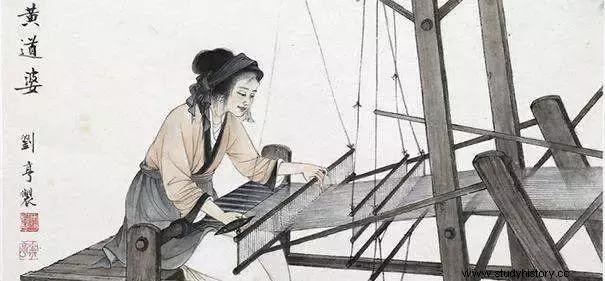A semi-legendary Chinese inventor, Huang Daopo (1240 or 1245 – 1330) is famous for developing, spreading and inventing weaving and spinning techniques, laying the foundations of the Chinese textile industry.
Child-wife

Little is known of Huang Daopo's life. She was born between 1240 and 1245 to a poor family in the Songjiang district of Shanghai, during the Yuan dynasty. At about ten years old, the girl is sold in marriage to a local family, and becomes tongyangxi, “child-bride”. As is customary, she goes to live with her husband and places herself under the authority of her parents-in-law, the custom being that the mother-in-law can thus train her daughter-in-law in household chores.
With her in-laws, Huang Daopo is overwhelmed with chores and abused and mistreated, to the point that she eventually runs away. After breaking through the thatched roof of the house to give way to her guests, she follows the Huangpu River and then embarks on a boat bound for Yazhou – today Sanya – on the island of Hainan, in the very south of China. .
Weaver and spinner
On the island of Hainan, Huang Daopo is welcomed by members of the Li people. At their side, she learns weaving and spinning techniques, which are an important part of Li culture:the traditional textile of the Li people is now classified as a UNESCO World Heritage Site, on the list of intangible heritage in need of urgent safeguarding. Endowed with a great work force, the young girl learned to grow cotton, and spent thirty years on the island of Hainan to perfect her knowledge, skills and technique.
Huang Daopo then returned to Shanghai, where she transmitted to women the weaving and spinning techniques she had learned and which she combined with local methods. Beyond this work of transmission, she also works to design textile machines in order to facilitate the work and improve the efficiency of her technique. In particular, she created a cotton gin and a loom with a pedal operating a wheel on which three spools of thread were installed. Using her tools, and the different techniques she masters, Huang Daopo creates costumes, sheets, fine silk fabrics, and invents new patterns that meet with success.
Grandmother Huang
Huang Daopo died in 1330, but his legacy lives on. Its weaving techniques and tools gradually spread in China and made the Songjiang textile industry flourish. The region then became an important center for weaving and spinning, establishing the foundations of the Chinese textile industry.
Many tributes will be paid to him thereafter. The Shanghai Botanical Garden houses a memorial in her honor, a Venusian crater was named after her, the Chinese series A Weaver on the Horizon (2010) is based on her life, and a popular song pays homage to her:"Grandmother Huang, Grandmother Huang, you teach me to spin, you teach me to weave, with two spools of thread and two pieces of cloth…” .
